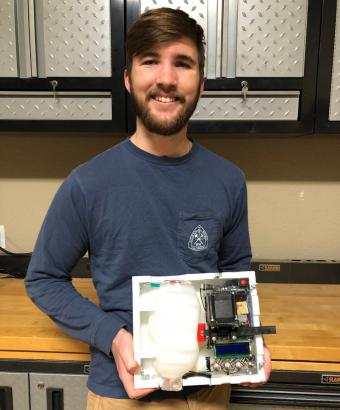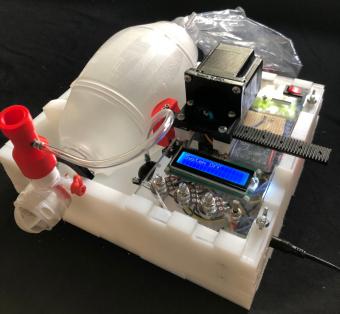As COVID-19 spreads around the world, Mines student designs low-cost ventilator

A Colorado School of Mines student is developing a low-cost ventilator that could be used in health care settings around the world where the traditional-style medical device is unavailable, too costly or too cumbersome.
Grant Kahl, a freshman in electrical engineering, started working on the P-Vent about three weeks ago at his home in San Antonio. Within 24 hours, he and a high school friend had a working prototype.
“Our main goal was to get something out there as quickly as possible,” Kahl said. “My buddy and I pulled in a few other students and put in over 400 hours in two and a half weeks. I wake up and do this.”
At the heart of the P-Vent is a bag valve mask, or Ambu bag, a commonly used manual resuscitator that provides positive pressure ventilation to patients who are not able to breathe adequately on their own.
Instead of requiring someone to squeeze the bag, though, the P-Vent uses a highly customizable motor system with a battery backup and power loss alarm to automate ventilation. The team also integrated responsive breathing capabilities into the controls – a feature missing in similar models being developed elsewhere across the country, Kahl said.
“Right now, everyone is producing these units and they’re just basic compression units. They’re just forcibly squeezing air. But there’s a lot of research coming out that that’s not going to help solve the problem,” Kahl said. “What we did as a team is ask, how can we make this more responsive to the individual? We were able to integrate responsive breathing into our system, with a pressure trigger that can indicate when the patient is trying to breathe. We can actually detect when the patient is breathing and have the machine respond, to preserve their lungs and increase their chance of survival.”

Also assisting on the project is Eric Love, an incoming computer science student at Texas A&M University; Jeffrey Kahl, a chemist and Grant’s father; and two student programmers from the University of Texas at San Antonio. A family friend at Joint Base San Antonio’s Medical Education and Training Campus provided a ventilator calibration unit to test their system.
“I’ve been doing underwater robotics for five or six years, and I’ve been to international competitions a few times, but nothing medical grade or quite like this,” Grant Kahl said. “It’s been quite a learning experience, learning all about what a ventilator is, what it does, all the specs that are needed. The amount of coding we’ve had to do on top of all that is insane.”
And while the emergency demand for ventilators appears to be waning in the United States, the cost savings offered by the P-Vent could still make it an excellent option for countries without the financial resources to buy traditional ventilators, which cost thousands to tens of thousands of dollars, Kahl said. The U.S. military has also expressed interest in the design for use in field hospitals.
“We built a ventilator for $500 all in, with manufacturing. The overall material cost was under $150,” Kahl said. “I really hope to see this put in use somewhere. Because of its size, it makes a really good field unit. It can be deployed to locations that are really hard to get to and it’s low-cost so it’s available to any country who needs it. To see it put into production would be a dream come true. It would be amazing to be able to make a difference like that.”




